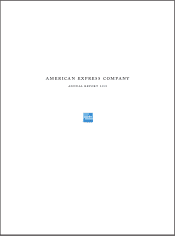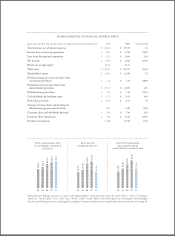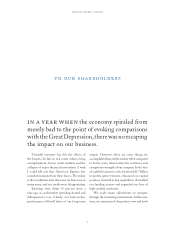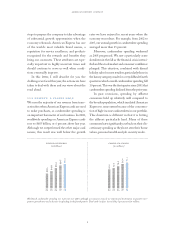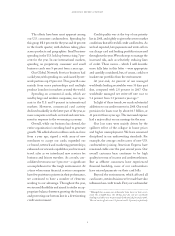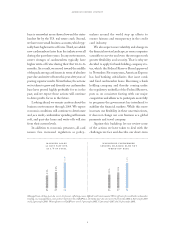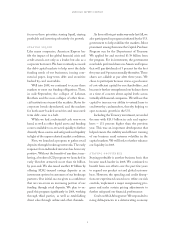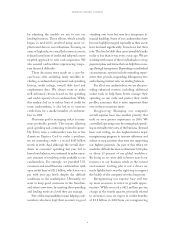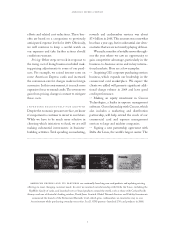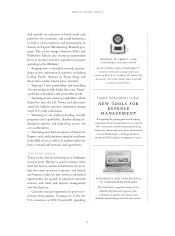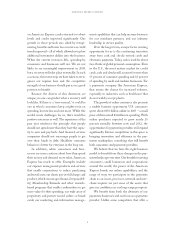American Express 2008 Annual Report Download - page 5
Download and view the complete annual report
Please find page 5 of the 2008 American Express annual report below. You can navigate through the pages in the report by either clicking on the pages listed below, or by using the keyword search tool below to find specific information within the annual report.
american express company
3
The effects have been most apparent among
our U.S. consumer cardmembers. Spending by
this group fell 1 percent for the year and 12 percent
in the fourth quarter, with declines taking place
across products and geographies. Small business
spending in the U.S. held up better, rising 7 per-
cent for the year. In our international markets,
spending on proprietary consumer and small
business cards rose 8 percent from a year ago.
Our Global Network Services business had
a solid year, with spending on cards issued by net-
work partners up 27 percent. This growth came
mainly from more partnerships and multiple
product launches in markets around the world.
Spending on commercial cards, which are
used by large and midsize companies, rose 4 per-
cent in the U.S. and 9 percent in international
markets. However, commercial card activity
declined markedly in the latter part of the year, as
more companies cut back on travel and entertain-
ment in response to the worsening economy.
Overall, while our business has slowed, the
entire organization is working hard to generate
growth. We added about 6 million cards-in-force
from a year ago; signed a wide array of new
merchants to accept our cards; expanded our
co-brand, network and marketing partnerships;
enhanced our rewards capabilities; and increased
travel sales as we introduced new services for
business and leisure travelers. As a result, con-
solidated revenues rose 3 percent – a significant
accomplishment in this tough environment. At
a time when many financial services companies
have few positives to point to in their performance,
we continued to have a number of elements
working to our advantage. Throughout the year,
we stressed flexibility and aimed to strike an ap-
propriate balance between growing the business
and protecting our bottom line in a deteriorating
credit environment.
Credit quality was at the top of our priority
list in 2008, and rightly so given the severe market
conditions that affected all credit card lenders. As
we had expected, late payments and write-offs in
our charge card and lending portfolios increased
throughout the year. We took steps to manage the
increased risk, such as selectively reducing lines
of credit. These moves – which I will describe
more fully later in this letter – were appropriate
and carefully considered, but, of course, could not
insulate our portfolio from the environment.
At year-end, 4.6 percent of our managed
worldwide lending receivables were 30 days past
due, compared with 2.8 percent in 2007. Our
worldwide managed net write-off rate rose to
5.4 percent from 3.3 percent a year ago.*
In light of these trends, we made substantial
additions to our credit reserves in 2008. Our total
provision for losses rose by about $1.7 billion, or
41 percent from a year ago. This increased expense
had a major effect on our earnings for the year.
Our loss rates were mainly driven by the
spillover effect of the collapse in home prices
and higher unemployment. We have remained
disciplined in our underwriting standards. For
example, the average credit scores of new U.S.
cardmembers joining American Express have
remained stable over the past several years. Our
overall customer base continues to be high
quality in terms of income and creditworthiness.
But as affluent consumers have experienced
financial hardship, more of our cardmembers
have missed payments on their card bills.
Beyond the environment, which affected all
card issuers, certain decisions we’ve made have also
influenced our credit trends. First, our cardmember
* Managed basis assumes our cardmember loans have not been securi-
tized. On a GAAP basis, the 30-day past-due rate for worldwide
lending receivables was 4.4 percent for 2008 and 2.8 percent for 2007.
The net write-off rate was 5.5 percent and 3.5 percent, respectively.

